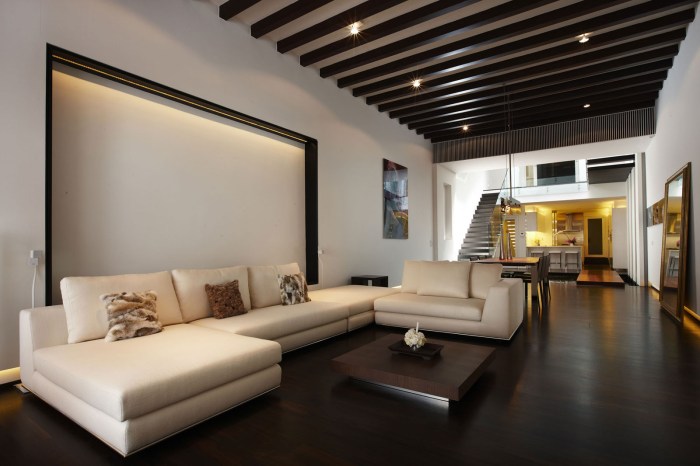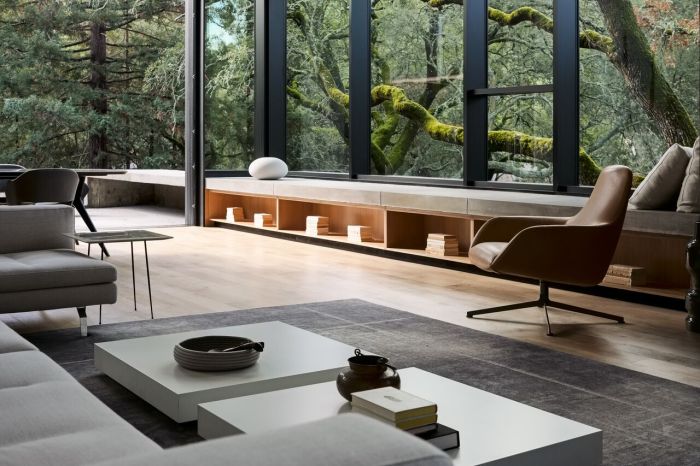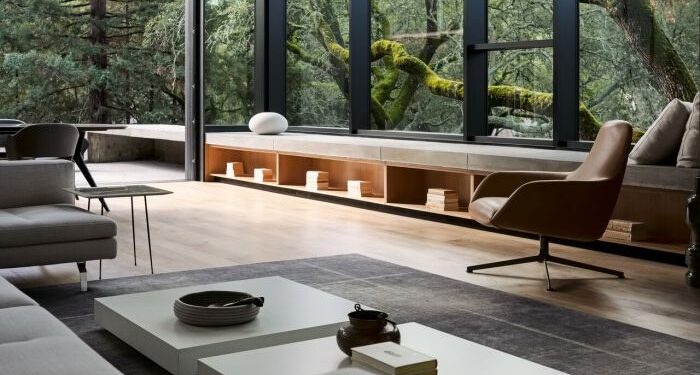Embark on a journey through the realm of interior architecture, where creativity meets functionality to shape captivating spaces. This article dives into the core concepts and elements that define this dynamic field, providing a comprehensive overview for enthusiasts and professionals alike.
Definition of Interior Architecture

Interior architecture involves the design and enhancement of interior spaces to achieve both functionality and aesthetics. It goes beyond mere decoration, focusing on the structural elements within a space to optimize its use and visual appeal.
Principles and Elements of Interior Architecture
Interior architecture is guided by several key principles and elements that ensure the creation of well-designed spaces:
- Space Planning: Efficient layout and organization of spaces to meet the needs of the users.
- Lighting: Utilization of natural and artificial lighting to enhance the atmosphere and functionality of the space.
- Materials and Finishes: Selection of appropriate materials and finishes to create a cohesive and visually appealing environment.
- Furnishings and Fixtures: Integration of furniture and fixtures that complement the overall design and functionality of the space.
- Color and Texture: Use of colors and textures to create visual interest and evoke specific moods within the space.
Importance of Interior Architecture
Interior architecture plays a crucial role in creating spaces that are not only visually appealing but also functional and conducive to the activities that take place within them. By considering the principles and elements mentioned above, interior architects can transform ordinary spaces into engaging environments that enhance the quality of life for the occupants.
History of Interior Architecture

Interior architecture has a rich history that has evolved over different time periods, influenced by various movements, styles, and cultural influences. These historical concepts continue to shape modern design practices, showcasing the enduring impact of the past on the present.
Ancient Civilizations
Interior architecture can be traced back to ancient civilizations such as the Egyptians, Greeks, and Romans. These societies displayed a keen sense of design and aesthetics in their interior spaces, incorporating elements like columns, frescoes, and intricate patterns into their architectural structures.
Renaissance and Baroque Period
During the Renaissance and Baroque periods, interior architecture saw a revival of classical elements and a focus on grandeur and opulence. Elaborate decorations, rich fabrics, and ornate details characterized the interiors of palaces, churches, and noble residences during this time.
Modern Movement
The modern movement in interior architecture, influenced by the Industrial Revolution and technological advancements, prioritized functionality, simplicity, and minimalism. Designers like Le Corbusier and the Bauhaus school embraced clean lines, open spaces, and innovative materials to create a new aesthetic that still resonates in contemporary design.
Postmodernism and Eclecticism
In the late 20th century, postmodernism challenged the modernist principles of form follows function, leading to a more playful and eclectic approach to interior architecture. Designers began mixing styles, textures, and cultural references to create spaces that were more personal and expressive.
Sustainability and Green Design
With a growing emphasis on sustainability and environmental consciousness, interior architecture has shifted towards green design practices. Incorporating eco-friendly materials, energy-efficient systems, and biophilic elements, designers are creating spaces that not only look good but also promote health and well-being.
Globalization and Cultural Fusion
In the contemporary era, interior architecture is influenced by globalization and cultural fusion, blending traditions, styles, and influences from around the world. This interconnectedness has resulted in a diverse and inclusive approach to design, reflecting the multicultural society we live in today.
Elements of Interior Architecture
Interior architecture is defined by a set of fundamental elements that work together to create functional and aesthetically pleasing spaces. These elements include space, light, form, texture, and color, each playing a crucial role in shaping the design of interior environments.
Space
Space is one of the primary elements in interior architecture, determining the layout and functionality of a space. Designers carefully consider the allocation of space to ensure optimal flow and usability within a given area. Whether it's an open floor plan or partitioned rooms, the manipulation of space is essential in creating a harmonious environment.
Light
Lighting is a key element that can dramatically impact the mood and ambiance of a space. Natural light, artificial lighting, and the strategic placement of light sources all contribute to the overall design. Light can highlight architectural features, create focal points, and influence how colors and textures are perceived within a space.
Form
Form refers to the shape and structure of objects within a space. From furniture and fixtures to architectural elements, the form plays a significant role in defining the visual appeal and functionality of the interior. Designers often play with different forms to create balance, contrast, and visual interest in a design.
Texture
Texture adds depth and tactile qualities to a space, enhancing the sensory experience. Whether through materials like wood, metal, or fabric, or through decorative elements like patterns and finishes, texture can create visual interest and evoke a sense of warmth or sophistication in interior architecture.
Color
Color is a powerful tool in interior architecture, capable of influencing emotions, perceptions, and spatial dynamics. Designers carefully select color palettes to establish a cohesive design scheme, create focal points, and evoke specific moods within a space. From bold accents to subtle hues, color plays a crucial role in shaping the overall aesthetic.Incorporating these elements thoughtfully and strategically, interior architects can create dynamic and engaging spaces that not only look beautiful but also serve the functional needs of their users.
Materials and Finishes in Interior Architecture
When it comes to interior architecture, materials and finishes play a crucial role in shaping the overall look and feel of a space. The selection of materials can greatly impact not only the aesthetics but also the functionality and durability of the design.
Types of Materials in Interior Architecture
- Wood: Wood is a versatile material that adds warmth and character to a space. It can be used for flooring, furniture, and wall finishes.
- Metal: Metal finishes such as stainless steel or brass are often used to create a modern and industrial look in interior design.
- Glass: Glass is a popular material for partitions, windows, and doors, allowing natural light to flow through the space.
- Stone: Stone materials like marble or granite are used for countertops, flooring, and decorative elements, adding a sense of luxury to the design.
Impact of Materials on Design
The choice of materials in interior architecture can significantly influence the design aesthetic. For example, using light-colored materials can make a space feel more open and airy, while dark materials can create a sense of coziness and intimacy.
Materials like glass and mirrors can visually expand a space, making it appear larger than it actually is.
Functionality and Aesthetics
- Functionality: The selection of materials should consider the practical use of the space. For instance, durable and easy-to-clean materials are essential for high-traffic areas like kitchens and bathrooms.
- Aesthetics: The texture, color, and finish of materials can greatly impact the visual appeal of a design. Mixing different materials can create contrast and visual interest in a space.
Spatial Planning and Layout
Spatial planning and layout play a crucial role in interior architecture by determining how spaces are organized and utilized within a design.
Importance of Spatial Planning and Layout
Effective spatial planning and layout are essential for creating functional and harmonious interior spaces. Architects and designers carefully analyze the available space to optimize its functionality and flow, ensuring that every area serves a purpose while maintaining a sense of balance and coherence.
Analyzing Spaces for Optimization
- Architects and designers assess the dimensions and proportions of a space to determine the best placement of furniture, fixtures, and circulation paths.
- They consider factors such as natural light, views, and traffic flow to create spaces that are both aesthetically pleasing and practical.
- By understanding the needs and behaviors of the occupants, architects can customize the layout to enhance comfort and convenience.
Innovative Spatial Planning Techniques
- Open-concept layouts that promote connectivity and flexibility, allowing for multipurpose use of spaces.
- Use of modular furniture and partitions to adapt spaces to different functions and accommodate changing needs.
- Zoning techniques that define specific areas for different activities, creating a sense of hierarchy and organization within the space.
- Integration of technology to enhance spatial planning, such as smart lighting and heating systems that can be controlled remotely.
Sustainability in Interior Architecture
Interior architecture has a significant role to play in promoting sustainability in the built environment. By integrating sustainable design practices, interior architects can contribute to creating healthier, more efficient, and environmentally friendly spaces. This involves considering the environmental impact of materials, energy consumption, and overall design decisions throughout the project.
Integration of Sustainable Design Practices
When it comes to interior architecture, sustainability is not just a trend but a fundamental aspect of the design process. Sustainable design practices are integrated into interior architecture projects in various ways:
- Utilizing eco-friendly materials: Interior architects prioritize the use of sustainable and non-toxic materials that have minimal environmental impact. This includes materials with recycled content, renewable resources, and low emissions.
- Implementing energy-efficient systems: Incorporating energy-efficient lighting, heating, and cooling systems helps reduce energy consumption and minimize the carbon footprint of the space.
- Applying green building principles: Interior architects follow green building standards and certifications to ensure that the project meets environmental performance criteria and promotes sustainability.
Benefits of Sustainable Interior Architecture
Sustainability in interior architecture not only benefits the environment but also enhances the overall quality of the built environment. Some key benefits include:
- Improved indoor air quality: Using eco-friendly materials and ventilation systems contributes to better indoor air quality, creating healthier living and working environments.
- Cost savings: Energy-efficient design practices can lead to reduced energy bills and operational costs over time, making sustainable interiors a cost-effective choice.
- Enhanced occupant comfort: Sustainable interior spaces are designed to prioritize occupant comfort and well-being, promoting productivity and overall satisfaction.
Conclusive Thoughts
In conclusion, interior architecture is a fascinating blend of artistry and practicality, shaping the way we experience and interact with the spaces around us. From historical influences to modern trends, the impact of interior architecture is profound and ever-evolving. Dive deeper into this captivating world to uncover endless possibilities for design innovation.
FAQ Summary
What sets interior architecture apart from interior design?
Interior architecture focuses more on the structural elements of a space, such as layout and spatial planning, while interior design deals with aesthetics and decoration.
How do materials and finishes impact interior architecture?
The choice of materials and finishes can greatly influence the functionality, durability, and overall aesthetic appeal of a space in interior architecture.
Why is sustainability important in interior architecture?
Sustainability in interior architecture promotes environmentally-friendly practices, resource conservation, and healthier living spaces for occupants.










